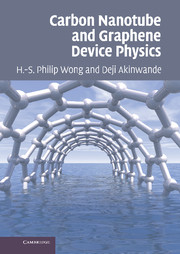Book contents
- Frontmatter
- Contents
- Preface
- 1 Overview of carbon nanotubes
- 2 Electrons in solids: a basic introduction
- 3 Graphene
- 4 Carbon nanotubes
- 5 Carbon nanotube equilibrium properties
- 6 Ideal quantum electrical properties
- 7 Carbon nanotube interconnects
- 8 Carbon nanotube field-effect transistors
- 9 Applications of carbon nanotubes
- Index
8 - Carbon nanotube field-effect transistors
Published online by Cambridge University Press: 05 June 2012
- Frontmatter
- Contents
- Preface
- 1 Overview of carbon nanotubes
- 2 Electrons in solids: a basic introduction
- 3 Graphene
- 4 Carbon nanotubes
- 5 Carbon nanotube equilibrium properties
- 6 Ideal quantum electrical properties
- 7 Carbon nanotube interconnects
- 8 Carbon nanotube field-effect transistors
- 9 Applications of carbon nanotubes
- Index
Summary
Innovation is everything. When you are on the forefront, you can see what the next innovation needs to be.
Robert Noyce (co-inventor of integrated circuits and co-founder of Intel)Introduction
In analogy to a water pipe that allows the guided flow of water, a transistor is an electronic device that allows for the guided flow of electrons with the key innovation being the influence of a gate that controls the amount of flowing electrons (the gate is similar in concept to a valve controlling the amount of water). The most popular flavor of the transistor is the field-effect transistor (FET), which came to reality in 1960 and forms the cornerstone of modern electronics that has revolutionized computing, communications, automation, and healthcare and fosters today's digital lifestyles. In part due to the continuous miniaturization or scaling of the transistor dimensions, silicon (Si) has evolved to be the de facto semiconductor for making transistors that enable smaller, faster, cheaper, and more power-efficient integrated circuits (also called chips) for an extensive variety of applications. However, transistor scaling and the resulting performance enhancement cannot continue forever owing to both physical and technical reasons. Obviously, the transistor cannot be reduced to a size of zero length for example, and this imposes a physical limit to the miniaturization of devices. Fortunately, we have yet to reach this physical limit. At present, the more pressing issues are technical in nature: relating to the challenges of fabricating small transistors and, in addition, the significance at short size scales of some otherwise undesirable device phenomena which are collectively referred to as short-channel or small-dimension effects.
- Type
- Chapter
- Information
- Carbon Nanotube and Graphene Device Physics , pp. 191 - 232Publisher: Cambridge University PressPrint publication year: 2010



